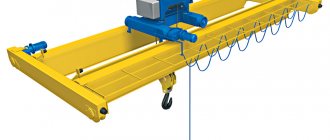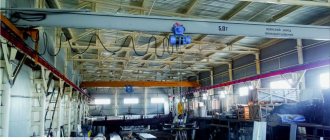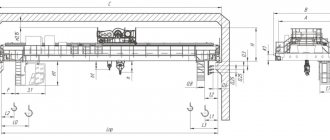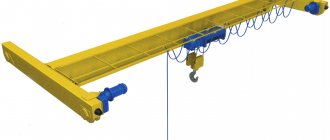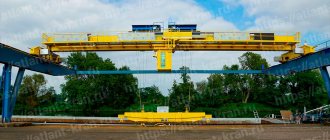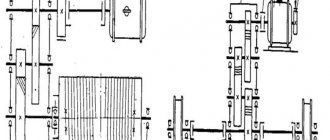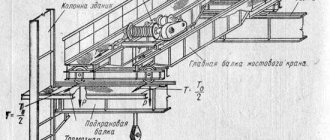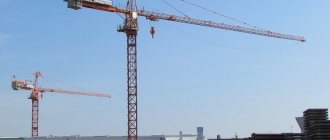In any production where you need to lift huge loads, beam cranes are needed. The main thing when installing equipment is safety. Work should only be carried out by professionals with detailed knowledge of the equipment being installed. Installation takes more time, the more complex the design of the crane beam. The equipment can be installed in different ways, depending on the characteristics of the crane beams.
During installation, various devices are used: a self-propelled installation crane, an installation mast or various metal structures (trusses, columns). The last option is the best.
Three stages of installation:
- Place all spare parts of the crane beam in the area where the installation will take place.
- Collect all the parts on the tracks under the crane.
- Raise the bridge.
All the following conditions must be present to begin installation of the crane beam:
- The installation of metal connections and structures has been fully completed. The structures may not be installed on the entire structure; at least five spans are required.
- The tracks were laid under the crane.
- The railway track has been installed.
- The length of the installation zone in the span of the structure is equal to double the length of the entire bridge.
Further installation of equipment is possible upon receipt of a certificate of completion of the installation of tracks under the crane, which is issued for all tracks in their entirety or for a section of them. Before installing the crane beams, you need to carefully check everything that could break. Let us remind you that welding is carried out at a temperature not lower than -20˚, and it is important to protect welding seams from dirt and splashes.
Preparatory stage
The installation of the crane beam depends on the structure - supporting or suspended. Advantages of choosing a support crane beam:
- high reliability and load capacity;
- there is no load on the walls of the building.
The main disadvantages of this type of hydraulic lifting machine are the additional costs for special supports - columns, because of this they have a limited working space without the hook approaching the walls and corners.
Advantages of overhead crane beam:
- does not hide the height of the room;
- has an approach to walls and corners.
Typically, a suspended crane beam is attached to the ceiling or floor of a building, and therefore has a lower load capacity due to limited strength of the supporting structures. The main disadvantage is the constant maintenance and repair due to the load placed on the lower part of the crane runway.
Before proceeding with the installation of the unit, it is necessary to develop a design for the installation of a gas and hydraulic machine, as well as make sure that the length of the span and the bridge correspond. The distance from the top of the tap to the ceiling must be at least 100 mm; from the ends to the side surfaces (walls, columns or passage galleries) at least 60 mm. You also need to check the condition of the walls - they must withstand the weight of the crane and its load. Ensure safety at the site of assembly and installation of the crane beam.
All parts of the crane are laid out and inspected for defects, the strength of bolted and welded joints is checked. Any faults and inaccuracies found in the components are eliminated.
It is important to remember that welding at temperatures below -20°C is prohibited.
After that, supports are installed and crane tracks are mounted, ensuring minimal horizontal and vertical deviations.
For further assembly, it is impossible to do without drawing up a report on the installed crane tracks. It can be issued for part of the route or for the entire section.
Advantages and disadvantages
The use of crane equipment involves 2 options for its installation:
- supporting;
- suspension.
Each option has its own disadvantages and advantages. Support systems are more reliable, so they are considered relatively safe. They have a long span. They demonstrate greater stability when moving heavy objects. They have a longer service life. The machines are more productive, so they can be used to move massive loads.
The disadvantages of hanging systems include their high cost. First of all, this applies to mechanisms that are designed to move heavy loads. Support cranes are not installed in corridors and narrow rooms. Electronic systems are quite demanding, so they require regular maintenance.
Installation technology
The installation procedure depends on the installation method of the overhead crane:
- One-piece - all parts are assembled on the ground and the crane is installed in one go. This method is suitable for crane beams with a span of less than 16.5 m and requires the use of additional lifting equipment. Electrical equipment and a hoist are attached to the supporting beam, and the fastenings are checked. After which it is installed in the working position. At the end of installation, supports are placed to prevent the crane beam from falling off.
- Part by part - individual components of the crane are assembled and fastened one by one. This method is convenient when it is not possible to use additional gas and hydraulic machines, but it increases installation time. It is also used after repairing parts of the crane beam.
When installing a suspended crane beam, an I-beam is used - a beam with a profile in the form of the letter “H”. A hoist is installed on it using clamps, an electric drive, and mounted on crane tracks. Then supports are installed to prevent the crane from falling off.
After installation of the hydraulic lifting gear, in accordance with PB 10-382-00 “Rules for the design and safe operation of load-lifting cranes”, a full technical examination is carried out, which includes equipment testing and quality control. Commissioning works are carried out and a certificate of commissioning of crane equipment is drawn up.
PB 10-382-00 Rules for the design and safe operation of load-lifting cranes
1 file 2.68 MB
Beam cranes with a lifting capacity of up to 10 tons are not subject to registration with Rostechnadzor.
How to choose a crane runway
When placing and using an overhead crane, the rail track is subjected to high loads. That is why during its construction the following design requirements are imposed on the structure:
- the distance from moving equipment in any position to protruding parts of the building must be at least 0.1 m;
- the structure must be installed on special foundations or on workshop columns that can withstand the load when moving equipment with maximum load;
- in the transverse direction, the rail track must be strengthened with fixing elements - ties and spacers;
- the structure can be erected either separately or using inventory sections;
- rails must be secured in such a way that their mechanical and thermal deformation, as well as longitudinal or lateral displacement, are excluded;
- maximum rail deflections under load - no more than 1/500;
- Dead stops must be installed at the ends of the rails to prevent the trolley from derailing.
The rest of the list of requirements includes the necessary safety margin, metal quality, acceptable types of rails, installation procedure, etc.
Dismantling process
The main reasons for dismantling overhead cranes are to replace a failed unit or transport it to a new location. The main factors of unit failure are deflections of span beams, cracks and corrosion.
Algorithm for dismantling the crane beam:
- determine in what way and with the help of what auxiliary equipment the analysis will be carried out;
- identify and clear storage space for equipment prior to transportation;
- fence off the site and ensure safety during work;
- install brake pads under the crane wheels;
- disconnect the power supply unit from the power supply;
- remove the hoist and electrical equipment;
- remove the bridge;
- remove the end beams (for supporting crane beams).
Further actions depend on the reason for dismantling. To be sent to a new location, disassembled units are packaged, labeled and transported to their destination. In case of replacement, large elements are cut and sent to a scrap metal collection point, since repairing the crane beam is not economically profitable.
Connecting metal structures with bolts
Bolted connections can be made with bolts of varying accuracy depending on the purpose of the connection and the loads it can bear. Fasteners of normal and high accuracy are mainly used. For connections that are subject to shear loads, normal and rough precision bolts must not be used.
Holes for bolts are drilled or pressed so that the diameter of the hole exceeds the outer diameter of the bolt by 2-3 mm. This simplifies assembly, but makes them less resistant to deformation. For this reason, bolts classified as coarse and normal in accuracy class are used only when one element directly rests on another. Examples include connections on support tables, strips and flanges.
Connections that use high-precision bolts are an alternative to rivet connections in hard-to-reach areas. For such connections, the diameter of the holes is larger than the diameter of the bolt by up to 0.3 mm. If this requirement is met, the bolts sit in the holes very tightly and withstand shear loads well.
High strength bolts are the most effective fasteners. They combine high load-bearing capacity with significant resistance to deformation. Such bolts can be used instead of rivets in almost all connections. The nuts for such bolts are tightened using ratchet wrenches, which allows you to control the tightening force.
Crane beam maintenance
In order to extend the life of the crane and ensure the safety of people working with it, it is necessary to follow a number of rules:
- inspect lifting equipment daily before starting work;
- conduct a fire safety compliance check once a month;
- regularly carry out scheduled technical inspections for early detection and prevention of faults;
- To work with the hydraulic and mechanical equipment, allow workers who have undergone training and instructions, as well as a medical examination.
Scheduled technical inspection and maintenance include:
- inspection of all structures and parts for integrity and performance;
- assessment of the condition of nodes, connections, fasteners and seams;
- checking electrical equipment and braking systems;
- search and replacement of worn or faulty parts and mechanisms.
Repairing a crane beam “pleasure” is expensive, and installation and dismantling is resource-intensive, and it is more advisable to carry out scheduled inspections and preventative work to correct problems on time.
General device
A beam crane differs from an overhead crane in that it has only one main beam part. It consists of:
- lifting device;
- span beam - the trajectory of its movement;
- end beams.
The work cycle consists of several operations:
- lifting the load to a given height;
- its horizontal movement to the place of installation work or laying;
- unloading materials;
- returning to the starting position.
This design is convenient:
- compactness - it can be used in small spaces;
- ease of installation;
- ease of maintenance;
- sufficient load capacity;
- affordable price.
Beam crane design
What does the cost of work depend on?
Construction of buildings using metal structures is inexpensive. The price for installation of metal structures is always calculated individually, since the tariff is formed taking into account many factors. Ordering is usually cheaper. But the following factors can affect the final cost:
- Building area. When installing metal elements, the size of the room is taken into account. Some companies offer discounts on wholesale orders if you plan to build a large hangar or pavilion.
- Complexity of design. Installing a garage is much cheaper than a shopping complex or pavilion for an industrial workshop. Therefore, some customers are advised to order simple but functional buildings to reduce costs. It can be a flat canopy instead of an arched one. From an aesthetic point of view, it loses, but will save the budget.
- Company pricing policy. Some companies position themselves as highly qualified professionals, so their rates are 30% higher. The quality of the work performed will not be better than in an ordinary average company. They usually include in the price the costs of advertising and promoting oneself on the market, and such costs usually have nothing to do with the quality of installation.
- Presence of forged elements. Some customers want a unique design and order metal structures with forged elements. Aesthetically, they look attractive, but you have to pay extra for exclusivity.
The complexity of the task also affects the final cost. Experts will calculate how far the object is from the city, what the terrain features are, whether there is infrastructure (convenient access, connection to the power grid, ability to accommodate workers). An important factor is also the qualifications of the personnel involved in the work.
Metal structures are used in various fields of human activity. They have a lot of advantages, they are characterized by mobility and ease of use in construction. Finished products are cheap and reliable; they make excellent industrial buildings, barns, and shopping complexes. Their production does not take much time, and they are convenient to use and transport. Installation does not take much time, which is the main advantage of using metal structures in construction.
Operating principle of the circuit
The engine is connected to power through the contacts of a reversing pair of starters KM1 and KM2, which, in turn, receive power through block contacts and forward-backward buttons. The entire circuit is protected using a thermal relay. A three-pole circuit breaker is installed at the power input.
When you press the “forward” button, the KM1 starter is started, which, by opening its block contact BKM1, prevents the “back” button from being pressed. As a result of this, the power contacts of KM1 connect power to the motor and the beam begins to move forward. When the button is released, the contactor opens the circuit, de-energizing the engine and closing BKM1, thereby supplying power to the lower half of the circuit. When you press the "back" button, the same thing happens, only the cart moves backward. Here is the second diagram.
This circuit is identical to the first, with the only difference that there are two automatic machines, and instead of thermal protection, a frequency control device is installed.
It is not possible to analyze the operation of radio control panels, since an explanation of the principles of radio control could be the topic of a separate article, and manufacturers of such devices are in no hurry to post circuit diagrams of their devices on the network for security reasons.
I will only say that such devices can become more convenient to operate due to the absence of wires, which means they have a higher safety class for the operation of lifting devices, since the operator is not tied by a cable to the mechanism itself and can be at a safe distance from the load being moved by the beam.
The appearance of possible radio control devices is shown at the beginning of the article, although these devices may have other configurations (for example, with a remote control suspended from the operator’s belt).
What else I would like to say about the crane beams and the consoles for them is that when working on any type of crane beam, it is imperative to follow the safety rules developed for those who work with lifting mechanisms. And these rules say:
- do not stand under a load;
- follow safety rules when working with electricity (after all, the drives are powered by electric motors);
- it is necessary to work in a protective helmet;
- strictly check the condition of the remote control before starting work;
- During operation, be sure to ensure that no strangers appear in the operating area of the device;
- For radio remote controls, it is necessary to check the presence and serviceability of batteries every time before starting work.
I hope that my article helped to understand at least a little the principles of operation of crane beams and the control panels with which they can work.
Write comments, additions to the article, maybe I missed something. Take a look at the site map, I will be glad if you find anything else useful on my site. All the best.
